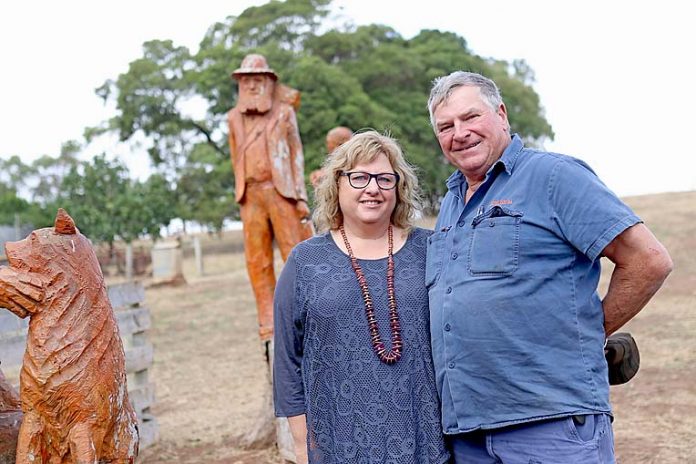

A SERIES of hand-crafted wood carvings which depict Mount Gambier’s history are rotting away on the city’s outskirts.
Echo Farm owners Linda and Bruce Hay have reached out to the community in a bid to save the iconic statues, created by veteran chainsaw sculptor Kevin Gilders.
“Trees are really part of the whole timeline of Australian history,” Ms Hay said.
“These carvings were completed around 10 years ago and you can just see them rotting from the inside out.
“We have not done anything yet as we are afraid they might fall apart on us.”
Mr Gilders is renowned for his Dartmoor memorial sculptures, as well as the Father Woods sculptures north of Penola, which have both recently been restored for the same reason.
Ms Hay believes the sculptures are a unique way of portraying the history of Mount Gambier.
“The whole aim of Echo Farm is to let visitors, families and school students understand and learn a bit about olden days farming and the carvings tie in nicely,” Ms Hay said.
“The cypress pine trees that make up the carvings were planted by one of the first farmers who owned the property hundreds of years ago.
“This adds to the importance of the carvings and gives more reason to salvage them one way or another.”
Ms Hay said many people had suggested employing a professional wood carving business but conceded it was not a clear-cut option.
“This was originally looked into out a few years ago when receiving a quote from a Millicent carving establishment but sadly was not acted on,” Ms Hay said.
“Their advice is to scrap the sculptures and replace them with new ones.
“We are not in financial a position to employ anyone to fix these or carve new ones and there are no other trees on the farm suitable as replacements.”
Ms Hay said the couple had tried everything to prevent the deterioration of the carvings but conceded the rotting was “inevitable.”
“In winter we cover them with black plastic to keep the water and weather away and to prevent any further damage,” Ms Hay said.
“As the trees were dead 10 years ago the stumps are now rotting and seeping into the sculptures themselves.
“We know that if we cut the sculptures off they will fall apart.”
Ms Hay said the seven carvings highlight the timeline of Mount Gambier’s history and have a distinct meaning.
The first carving First Her is a Boandik man with a boomerang which symbolises acknowledgement of the traditional owners and the 10,000-year-old boomerangs that have been excavated at Wyrie Swamp about 45km from the farm.
A figure of a European explorer titled Exploring the Unknown commemorates the proclamation of South Australia as a province in 1836.
Two primary school children named Settler’s Children show the history behind schooling after people lived in the Mount Gambier area after being founded in 1854.
The Light Horseman carving commemorates World War I.
The two sculptures titled Making Do and The Swagman depict the Great Depression in 1930’s – one is of a swagman with his bundle and the other is of a woman collecting wood for her
fire.
The last figure pictures a soldier says goodbye to his dog titled Goodbye Mate, commemorating World War II.
Ms Hay said it would be a “real pity” to see the sculptures rot away.
“They are part of our learning aspect which we try and promote on our farm,” she said.
“It would be disappointed to see them rot not away only for the city history but also the farm as well.
“If there is someone out that is used to working with wood we would appreciate some of their time to volunteer and help us restore the carvings to their former glory.”







